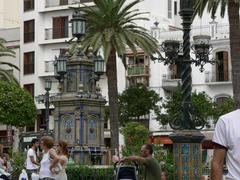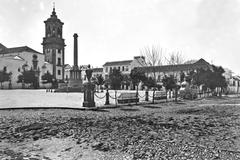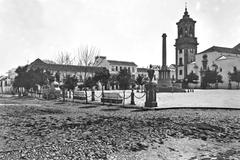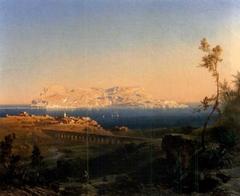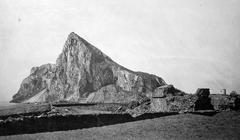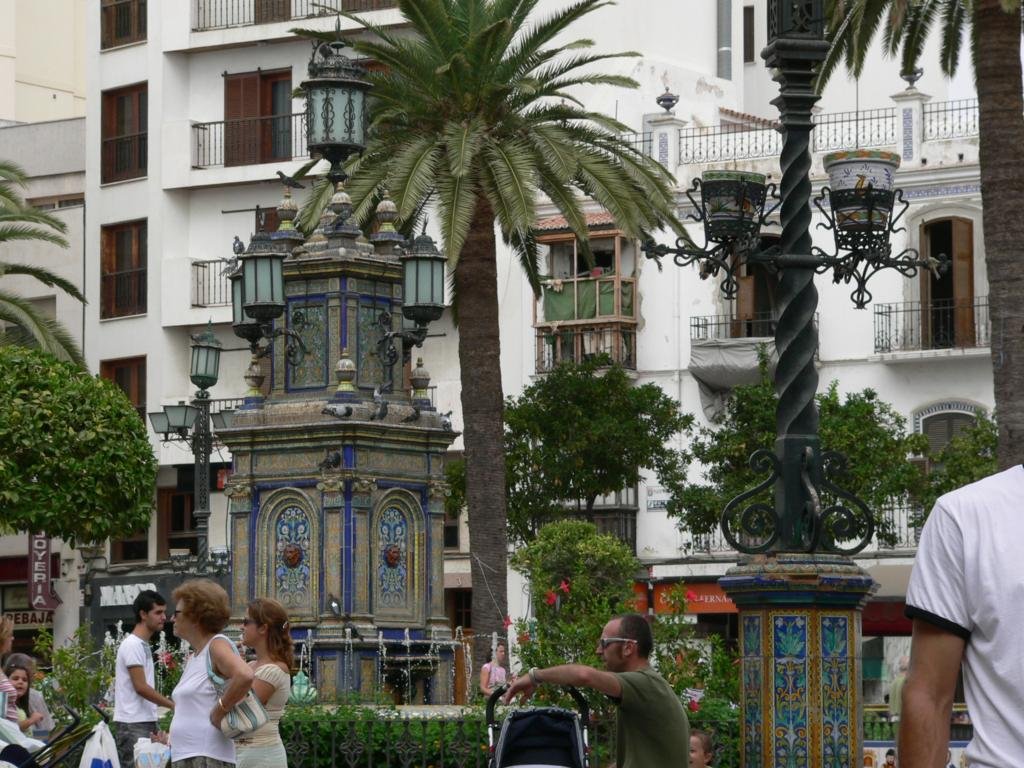
Comprehensive Guide to Visiting Plaza Alta, Algeciras, Spain
Date: 18/07/2024
Introduction
Plaza Alta, located in the vibrant city of Algeciras, Spain, is a historical and cultural gem that attracts both locals and tourists alike. This iconic square is not merely a place to visit; it’s a portal into the deep and layered history of Algeciras, where each stone and every building narrates tales of ancient civilizations, conquests, and cultural exchanges. From its ancient origins with the Phoenicians and Romans to its Moorish splendor and subsequent transformations during the Reconquista, Plaza Alta has evolved into a modern urban space while retaining its historical essence. Today, it stands as a bustling center of social and cultural life, surrounded by significant landmarks such as the Iglesia Mayor de la Palma and the Ayuntamiento de Algeciras.
Table of Contents
- [A Glimpse into the Past - Plaza Alta’s Historical Tapestry](#a-glimpse-into-the-past---plaza-altas-historical-tapestrya-glimpse-into-the-past---plaza-altas-historical-tapestry)
- [From Ancient Origins to Moorish Splendor](#from-ancient-origins-to-moorish-splendorfrom-ancient-origins-to-moorish-splendor)
- [Reconquest and Transformation](#reconquest-and-transformationreconquest-and-transformation)
- [A Modern Square with Ancient Roots](#a-modern-square-with-ancient-rootsa-modern-square-with-ancient-roots)
- [Visiting Plaza Alta - Practical Information](#visiting-plaza-alta---practical-informationvisiting-plaza-alta---practical-information)
- [Visiting Hours](#visiting-hoursvisiting-hours)
- [Tickets](#ticketstickets)
- [Accessibility](#accessibilityaccessibility)
- [Tips for Visitors](#tips-for-visitorstips-for-visitors)
- [Best Time to Visit](#best-time-to-visitbest-time-to-visit)
- [Nearby Attractions](#nearby-attractionsnearby-attractions)
- [Guided Tours](#guided-toursguided-tours)
- [Plaza Alta Today - A Tapestry of Time](#plaza-alta-today---a-tapestry-of-timeplaza-alta-today---a-tapestry-of-time)
- [FAQs](#faqsfaqs)
- [Key Attractions and Landmarks](#key-attractions-and-landmarkskey-attractions-and-landmarks)
- [Iglesia Mayor de la Palma (Church of Our Lady of the Palm)](#iglesia-mayor-de-la-palma-church-of-our-lady-of-the-palmiglesia-mayor-de-la-palma-church-of-our-lady-of-the-palm)
- [Capilla de Nuestra Señora de Europa (Chapel of Our Lady of Europe)](#capilla-de-nuestra-señora-de-europa-chapel-of-our-lady-of-europecapilla-de-nuestra-señora-de-europa-chapel-of-our-lady-of-europe)
- [Monumento a la Conferencia de Algeciras (Monument to the Algeciras Conference)](#monumento-a-la-conferencia-de-algeciras-monument-to-the-algeciras-conferencemonumento-a-la-conferencia-de-algeciras-monument-to-the-algeciras-conference)
- [Ayuntamiento de Algeciras (Algeciras Town Hall)](#ayuntamiento-de-algeciras-algeciras-town-hallayuntamiento-de-algeciras-algeciras-town-hall)
- [Plaza Alta - A Hub of Local Life](#plaza-alta---a-hub-of-local-lifeplaza-alta---a-hub-of-local-life)
- [Visitor Information](#visitor-informationvisitor-information)
- [Travel Tips](#travel-tipstravel-tips)
- [Special Sections](#special-sectionsspecial-sections)
- [Conclusion](#conclusionconclusion)
- [References](#referencesreferences)
A Glimpse into the Past - Plaza Alta’s Historical Tapestry
From Ancient Origins to Moorish Splendor
The story of Plaza Alta and indeed Algeciras itself begins with the Phoenicians, master seafarers who established a presence in the area as early as the 7th century BC. While the exact location of their settlement, known as “Portus Albus” (White Port), is debated, it’s believed to be closely linked to the Plaza Alta area. This strategic location, overlooking the Bay of Gibraltar, made it a coveted prize for various civilizations.
The Romans, inheriting the Phoenician legacy, further developed the settlement, leaving their own architectural imprints. However, it was under the Moors, who conquered the Iberian Peninsula in the 8th century AD, that Algeciras truly flourished. They renamed the city “al-Jazirah al-Khadra” (Green Island), a testament to the lush vegetation surrounding the area.
During the Moorish reign, Plaza Alta emerged as the city’s central square, a hub of social, commercial, and religious life. The Moors, known for their architectural prowess, adorned the square with intricate fountains, vibrant gardens, and bustling marketplaces. The echoes of this era are still palpable in the narrow, winding streets that radiate out from the Plaza, reminiscent of traditional Moorish urban design.
Reconquest and Transformation
The Moorish dominion over Algeciras, however, was not to last. In 1344, after a prolonged siege, King Alfonso XI of Castile captured the city, marking a turning point in Plaza Alta’s history. The square, once a symbol of Moorish power, became a stage for Christian celebrations and processions.
The Reconquista, as this period is known, brought about significant architectural changes to Plaza Alta. The existing mosque, a prominent feature of the Moorish square, was replaced with the Iglesia de la Palma (Church of the Palm), a symbol of the newly established Christian order. This church, though rebuilt and renovated over the centuries, still stands today, a silent witness to the shifting tides of history.
A Modern Square with Ancient Roots
Over the following centuries, Plaza Alta continued to evolve, reflecting the changing face of Algeciras. New buildings, reflecting architectural styles from different periods, sprung up around the square, creating an eclectic yet harmonious blend of the old and the new.
The 19th century saw the construction of the Ayuntamiento (City Hall), a neoclassical edifice that added a touch of grandeur to the square. The 20th century brought further modernization, with the introduction of electric lighting, paved streets, and public transportation, transforming Plaza Alta into the bustling urban space it is today.
Visiting Plaza Alta - Practical Information
Visiting Hours
Plaza Alta is an open square and can be visited at any time. However, the Iglesia de la Palma has specific visiting hours which are typically from 10 AM to 6 PM. It’s advisable to check the church’s official website for the most up-to-date information.
Tickets
There is no entry fee to visit Plaza Alta. However, if you wish to explore the interior of Iglesia de la Palma, there might be a nominal fee.
Accessibility
The square is easily accessible and pedestrian-friendly. There are ramps for wheelchair access, and public transportation options are available nearby.
Tips for Visitors
Best Time to Visit
Early morning or late afternoon when the square is less crowded and the light is perfect for photography.
Nearby Attractions
Don’t miss the nearby Central Market of Algeciras for a taste of local life, and the beautiful Parque Maria Cristina for a relaxing stroll.
Guided Tours
Consider joining a guided tour to fully appreciate the historical significance of Plaza Alta and its surrounding areas.
Plaza Alta Today - A Tapestry of Time
Today, Plaza Alta stands as a vibrant testament to Algeciras’s multifaceted past. The Iglesia de la Palma, with its towering bell tower, serves as a reminder of the city’s Christian heritage. The narrow, winding streets, a legacy of the Moorish era, invite exploration and discovery. And the bustling cafes and shops that line the square reflect the city’s modern, cosmopolitan spirit.
A visit to Plaza Alta is akin to stepping back in time. The square’s historical layers are not just etched in its architecture but also woven into the fabric of daily life. As locals and visitors converge in this vibrant space, sipping coffee, sharing stories, or simply soaking up the atmosphere, they become part of Plaza Alta’s ongoing narrative, a story that continues to unfold with each passing day.
FAQs
- What are the visiting hours for Plaza Alta? Plaza Alta is open 24/7. However, for specific landmarks like the Iglesia de la Palma, it’s best to check their official visiting hours.
- How much do tickets to Plaza Alta cost? Plaza Alta itself is free to visit. There may be a small fee for entering certain historical buildings, like the Iglesia de la Palma.
- Are guided tours available? Yes, guided tours are available and highly recommended to fully appreciate the historical context of Plaza Alta.
Key Attractions and Landmarks
Iglesia Mayor de la Palma (Church of Our Lady of the Palm)
Dominating the plaza with its imposing facade is the Iglesia Mayor de la Palma. Built in the 18th century on the site of a former mosque, this church stands as a symbol of the city’s rich and layered past. Its Baroque style, characterized by intricate details and a sense of grandeur, is a testament to the architectural trends of the time.
Inside, visitors are greeted by a serene atmosphere and beautiful works of religious art. The altarpiece, dedicated to Our Lady of the Palm, the patron saint of Algeciras, is a masterpiece of craftsmanship. The church’s peaceful ambiance offers a respite from the bustling plaza outside, inviting contemplation and reflection.
Capilla de Nuestra Señora de Europa (Chapel of Our Lady of Europe)
Just a stone’s throw from the Iglesia Mayor de la Palma lies the Capilla de Nuestra Señora de Europa. This small chapel, dating back to the 17th century, holds deep religious significance for the city. It houses a revered image of Our Lady of Europe, believed to have been brought to Algeciras by King Alfonso XI after the city’s reconquest from the Moors.
The chapel’s simple yet elegant design, with its whitewashed walls and terracotta roof, reflects the traditional architecture of Andalusia. Its location, nestled amidst the lively atmosphere of Plaza Alta, creates a unique juxtaposition of the sacred and the secular.
Monumento a la Conferencia de Algeciras (Monument to the Algeciras Conference)
A prominent landmark in Plaza Alta is the Monumento a la Conferencia de Algeciras. This monument commemorates the Algeciras Conference of 1906, a significant event in international diplomacy. The conference, attended by major European powers, aimed to resolve the First Moroccan Crisis, highlighting Algeciras’ strategic importance on the world stage.
The monument itself is a striking example of early 20th-century design. Its intricate details and symbolic elements offer a glimpse into the political climate of the time. The monument serves as a reminder of Algeciras’ historical significance and its role in shaping international relations.
Ayuntamiento de Algeciras (Algeciras Town Hall)
Standing proudly on one side of Plaza Alta is the Ayuntamiento de Algeciras, the city’s town hall. This grand building, with its neoclassical facade and elegant balconies, reflects the architectural style prevalent in 19th-century Spain. Its central location and imposing presence underscore its importance as the seat of local government.
The town hall’s interior is equally impressive, featuring grand halls adorned with historical artifacts and works of art. While access to the interior may be limited, the building’s exterior alone is worth admiring, offering a glimpse into the city’s civic pride and architectural heritage.
Plaza Alta - A Hub of Local Life
Beyond its historical landmarks, Plaza Alta is a vibrant hub of local life. The plaza is lined with cafes, restaurants, and shops, offering a taste of authentic Algeciras. Visitors can enjoy a cup of coffee while soaking up the lively atmosphere, savor delicious tapas at a local bar, or browse for souvenirs in the surrounding shops.
The plaza comes alive in the evenings, with locals and tourists alike gathering to enjoy the pleasant weather and socialize. Street musicians often fill the air with music, adding to the vibrant ambiance. Plaza Alta truly embodies the spirit of Algeciras, offering a glimpse into the city’s soul and the warmth of its people.
Visitor Information
Visiting Hours
- Iglesia Mayor de la Palma - Open daily from 9 AM to 7 PM.
- Capilla de Nuestra Señora de Europa - Open daily from 10 AM to 6 PM.
- Monumento a la Conferencia de Algeciras - Open access at all times.
- Ayuntamiento de Algeciras - Limited public access; check local listings for special tours.
Tickets
- Iglesia Mayor de la Palma - Entry is free, but donations are welcome.
- Capilla de Nuestra Señora de Europa - Entry is free.
- Monumento a la Conferencia de Algeciras - Free to visit.
- Ayuntamiento de Algeciras - Tours may have a nominal fee; check local listings for details.
Travel Tips
Timing your visit
Plaza Alta is best enjoyed in the late afternoon or early evening when the weather is cooler and the plaza is buzzing with activity.
Exploring the surroundings
The streets surrounding Plaza Alta are also worth exploring, offering a glimpse into the city’s historic center with its charming shops and traditional architecture.
Trying local cuisine
Don’t miss the opportunity to sample the local cuisine at one of the many restaurants and cafes in and around the plaza.
Soaking up the atmosphere
Take your time to relax and soak up the lively atmosphere of Plaza Alta, observing the locals going about their day and enjoying the vibrant energy of this central gathering place.
Special Sections
Guided tours
Several local tour companies offer guided tours of Plaza Alta and its surrounding attractions. These tours often provide deeper historical insights and interesting anecdotes.
Photographic spots
The vibrant atmosphere, historic buildings, and lively street scenes make Plaza Alta a photographer’s delight. Key spots include the facades of the Iglesia Mayor de la Palma and the Ayuntamiento de Algeciras.
Special events
Plaza Alta hosts various events throughout the year, including religious processions, cultural festivals, and local markets. Check local listings for event schedules.
Conclusion
Plaza Alta in Algeciras is more than just a historical square; it is a living chronicle of the city’s rich past and vibrant present. From its ancient roots to its modern-day significance, Plaza Alta embodies the cultural and historical essence of Algeciras. The square’s landmarks, such as the Iglesia Mayor de la Palma and the Monumento a la Conferencia de Algeciras, offer visitors a glimpse into the architectural and political history that has shaped the city. The lively atmosphere, enriched by local cafes, restaurants, and shops, reflects the contemporary spirit of Algeciras, making Plaza Alta a central hub of social life.
